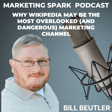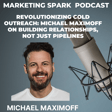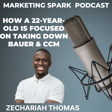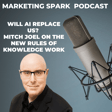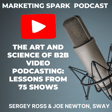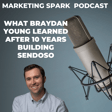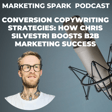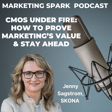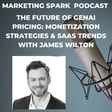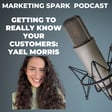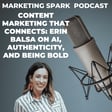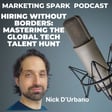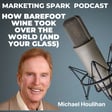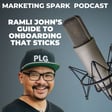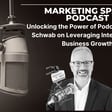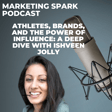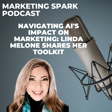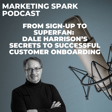Become a Creator today!Start creating today - Share your story with the world!
Start for free
00:00:00
00:00:01

How Brands Create Serious Marketing Momentum
What can brands do to position themselves to emerge from COVID as strong and dynamic players?
While many brands are struggling to keep their heads above water, the strongest brands are already thinking about what needs to be done outflank rivals with marketing that engages consumers in new and different ways.
On the Marketing Spark podcast, Ron Tite provides insight into how brands can build marketing momentum to pull away from the competition.
Transcript
Introduction to Marketing Spark
00:00:04
Speaker
My name is Mark Evans, and I'd like to welcome you to Marketing Spark, the podcast that delivers small doses of insight, tools, and tips for marketers and entrepreneurs in the trenches. By small doses, it's conversations that are 15 minutes or less.
Meet Ron Tite
00:00:18
Speaker
On today's show, I'm talking with Ron Tite, founder of Church & State, a content marketing agency based in Toronto. Ron is also a bestselling author and an in-demand speaker. Welcome to Marketing Spark.
00:00:30
Speaker
Thanks, Mark. I'm so excited to be here. Such a nice snackable way to do a podcast. We're going to cover a lot of ground in 15 minutes, so let's get started.
What is 'Think, Do, Say'?
00:00:40
Speaker
I wanted to begin by asking you about your most recent book, Think, Do, Say, which I think captures your approach to marketing in a noisy, busy world. Can you walk me through the different components?
00:00:51
Speaker
As you can probably imagine, there are three components to the book, think, do, say. There's the think part, the do part, and the say part. The problem with a lot of organizations, and it can be, it really is an operating system for an organization. It can be an operating system for a leader, or it can be a marketing system or an operating system for marketing. Many organizations, many marketers, many leaders choose one of the three.
00:01:21
Speaker
So they're like, they think, think, think, think, think, and they never actually do anything, which is useless. It's just useless. They overanalyze stuff. Or it's the organization that does, does, does. They're so focused on execution that they're just, you know, head down. They're do, do, do, do, do. It's not strategically aligned. It's totally random. And they're a sweatshop and no one wants to work with them.
00:01:46
Speaker
worse is the people who just talk about it, right? They're all say that they just talk about the things you're going to do, but they never actually do them. And those in the organization, they experience great churn. If it's a person, they get found out. So it really is all three together. So the think side is around what do you fundamentally believe in your heart of hearts? What do you fundamentally believe? Don't tell me what you sell, because other people sell that probably.
00:02:19
Speaker
What is your social cause? That is not, you know, what charities do you support? This is corporate purpose. Why do you do what you do? Then the do part is what do you fundamentally do to reinforce that purpose? And yes, that include what products do you make? That include what, you know, what clients do you chase? But what do you do? What is the experience for the people who interact with that purpose?
00:02:39
Speaker
What do you believe? What is your corporate purpose?
Aligning Belief, Action, and Communication
00:02:44
Speaker
How do you bring that purpose to life?
00:02:46
Speaker
And the third part is, look, if you believe in something more important, and you behave in a way consciously that reinforces that belief, that's worth talking about. Like, it's just worth talking about. So if it's worth talking about, then you should probably say it
00:03:03
Speaker
in a compelling way, in a consistent way. And when you combine all those three together, what you end up with is an organization that is bound by purpose. They are defined by their action and they are adopted and they grow through their communications. That is think, do, say.
How Did COVID Influence Marketing Strategies?
00:03:24
Speaker
It's interesting because a lot of companies in this current COVID environment, there's a lot of do and there's a lot of say. And the problem is that there's not a lot of think. My take is that companies aren't taking a smart strategic approach to marketing. They're in many cases, they're just throwing spaghetti at the wall to see what sticks. And as a result, you're getting a lot of noise out there and a lot of marketing that, that frankly, isn't effective. Yeah. My friend, Warren Tomlin, who's at EY is a great line for this, which is it's random acts of digital.
00:03:54
Speaker
So they're just they're just chasing random things, right? Like they go to they hear a speaker like me or you or they they they're like a new platform comes down. They're like, we got a bad tech talk, right? They're just they're just chasing these random things that aren't strategically sound and they're not laddering up to a higher purpose. The result of that mark is it's it's not only is it chaos, but it's
00:04:18
Speaker
It leads to higher margin or a lower margin, higher cost. It leads to a poor definition of success for your team. It leads to clutter around message. And then you step back and you go, we should have just done on what we did last year. You know, I mean, it's just, it's a, it is a horrible way to do it. Yeah. I think people are, they feel like they should be sprinting around doing a bunch of random things.
00:04:44
Speaker
opposed to stopping and really establishing what they believe and then chasing only the things that deliver on that.
00:04:54
Speaker
I think it makes marketers, a lot of marketers feel better because they can somehow justify to their bosses that they're busy and active and doing stuff. When we were talking in advance of this podcast, you talked about a concept of digital letdown and how advertising has become increasingly and overly complicated.
The Pitfalls of Digital Advertising
00:05:13
Speaker
Why has that happened and what are brands doing wrong?
00:05:17
Speaker
I think the core understanding, and I started as a traditional creative guy. I was doing TV spots and print ads and everything else. And I just remember all the digital folks who came in and would say, oh, just you wait. Oh, just you wait. Old advertising is going to be nirvana. We're going to be able to customize messages.
00:05:40
Speaker
On a individual level people will only see the ads that are specifically targeted at them and their interest and it's gonna just it's gonna get rid of all the waste and all the crap that you make. Let's see where this goes where did we land.
00:05:59
Speaker
We landed in a place where people took digital and used it for scale. And so now, it's not about customization at all. It is about touching, inappropriately or appropriately, as many people as possible. And because you can reach 5 million people for the same cost that you can reach 5 people, people are just dumbing it all down and going, well, you know what?
00:06:28
Speaker
My conversion rate is 0.00008%. I just need to add more people to grow my revenue. Can I swear on this podcast, Mark? You can now.
00:06:39
Speaker
People saying, I don't give a shit about the innocent bystanders.
Balancing Creativity and Data in Marketing
00:06:43
Speaker
I really don't. I don't care about the people who shouldn't receive that message because I just need to grow that top line number to grow my revenue. Don't care. That's horrible. That is a horrible place to be. It is a soulless place to be. I want to, you know, you flick the earlobe of, I want to flick the earlobe of anybody that does it.
00:07:03
Speaker
Well i think it's what happens when marketing becomes a game that's all about data and it's it's quantity over quality and one of the things i'm interested in hearing from you is. Is the focus on brand and branding these days because when everything can be measured when there's kpis for.
00:07:22
Speaker
anything that you can do digitally sometimes it can be hard to quantify the value and the impact of brand and i wonder whether that's that's a problem these days is that if you can't justify you shouldn't do it. It's a horrible place and it's a horrible place to be for marketers now i say that one as a credit guy have that bias like writing like creating from scratch and i get that i do value.
00:07:50
Speaker
the ability to look at a piece of work and say, this is not performing as well as this other piece. Or how can we optimize this piece to make it perform better? I get that. I totally get that. I get that you can make more money from the print than you can from the original. But the print only exists because somebody took the time to create an original.
00:08:15
Speaker
and you have to have a portion of your budget which is constantly exploring for new things and new angles because yes it's like you know in hollywood we know how a typical romantic story works right we know the script we know the three act you know part of the story all that and we know when somebody has done that and they perfected that assembly line.
00:08:39
Speaker
But the movies that really blow us away are the ones that nobody's ever done before. Those are the ones that really win the day. Now, which are the ones that really tank? Some of those same ones.
00:08:55
Speaker
So you can either follow the benchmark of what you should do and use the data to say, well, we find that a headline that starts with a three-syllable word performs better. And you can do that all day long and get a pretty good level of performance. Fine, go for it. But if you really want to hit it out of the park, you've got to do the stuff that nobody has ever done before. And the fact that data tells us what works
00:09:24
Speaker
It doesn't compute in stuff. You can't say, give me something that has never been done before and give me the benchmarks of how it's going to do. Those things are mutually exclusive. If you look at marketing as a pendulum where we had
00:09:42
Speaker
At one point time it was all about creative and now it's the pendulum has swung all the way to data. Do you see the pendulum coming back and what's a happy balance between what's a happy balance between creative and data. I guess they ideally they inform each other a hundred percent. I wrote a piece for Canada Post on this.
00:10:01
Speaker
My background's in comedy and here's what I know about comedy. For Chris, let's say Chris Rock. Chris Rock does a bit. He writes a bit, the original bit. He's really creative in that. He doesn't go on HBO or Netflix with that right away. No, no, no, no, no, no. He takes the original bit and then he tours it. And he uses the data, the just-in-time data of the audience response to go, oh, when I,
00:10:27
Speaker
flicked my hand when I delivered the punchline like that, that joke delivered, it performed way better. And so he perfects it by using real time data over time. And by the end, he's ready to the end of the year when he shoots his Netflix special. There is no improv in that comedy whatsoever. You don't improvise an eight camera shoot Netflix special.
Strategic Acceleration in Business
00:10:52
Speaker
You just don't he knows specifically what is going to work in that environment because he's used data along the way so great creative becomes great performing optimized creative one becomes the really original creative idea becomes the optimized idea but you can't just leapfrog all the way to the optimized idea and only we leave with the data approach doesn't work.
00:11:17
Speaker
I have to ask you about your racing car metaphor and how marketers have to navigate the curve so they hit the proverbial straightaway as effectively and efficiently as possible. Can you provide a little bit of color on how that metaphor works? Yeah. And I say this as a dude who hates car rate. Like I hate Formula One and NASCAR, but here's what I know. I know that nobody, I mean, I know that it's pretty easy to race in a straightaway, right? Like you just got it and that's it.
00:11:44
Speaker
I also know that races aren't one in the straightaways. Races are one in the corners. And so when a driver enters a corner, what they do is they slow down. They slow down so they can get control of the car. They need to do that. They need the car stable. And once they get the car stable, which is, that's where we're at right now, we entered the corner and businesses and marketers needed to go, whoa, whoa, whoa, whoa, whoa, whoa.
00:12:12
Speaker
There's a whole bunch of stuff happening. Let's just get things stable. Let's look at the data. Let's look at the dashboard and every single one of us slowed down as we entered the corner. Now, the amateur driver like me would think, just wait until the corners over, man. Then gun it again.
00:12:33
Speaker
But the professional driver knows that is not how it works the professional driver knows once you reach stability you accelerate in the middle of the corner and you do that so that you can leave the corner with as much momentum as possible and so we're in the middle of a corner.
00:12:52
Speaker
People are using the phrase new normal that means we reach stability it's time to get it and those brands and those organizations who accelerate earlier in the corner will have more momentum coming out of the corner whenever the hell it is so people need to step on the gas and that is see the sea leadership it's when you enter an environment of chaos you need to introduce some composure.
00:13:17
Speaker
But once you've reached composure, you've got to make sure that you don't hit complacency. So you introduce chaos to the composure to gain momentum.
Virtual Public Speaking Insights
00:13:27
Speaker
Sounds like a very interesting approach to management. I have to ask you about speaking because you're an extremely busy speaker. I think last year you may have talked somewhere in the range of 75 times. It's just incredible. What's it like to be a public speaker in the time of COVID?
00:13:45
Speaker
I liken it to like being on iMac. And so those who speak will know iMac, which is iMac is when a camera shoots you, you're live on stage in front of 500 people, and they put you on the screens, right? So the crowd is in the room watching you, but the reality is they're really watching the screen. So because of that, I love it because you can play it smaller, right? Like you can cock an eyebrow and everybody's gonna see it. So what I love about speaking
00:14:12
Speaker
in a virtual environment is I can play it really, really small and I could be really subtle and intimate. What is different about it and slightly challenging is I can't read the room because people are muted and I don't see their faces and stuff. So it's more of an acting thing than, you know, I know what line delivers or I know what joke delivers and I have to trust that I deliver it in the best way possible because I don't know. I don't hear the people laughing and I don't see their facial expressions.
00:14:42
Speaker
you had no data to feed on exactly so are you doing a lot of public speaking these days and yeah and how do you like what are the best speaking engagement these days how can you tell like what kind of what kind of metrics are you getting that says you did a great job because there's no applause these days or maybe there is there's no applause there's also a lack of social media you know before I could if I went in and spoke to a thousand people I'm going okay they're gonna be 200 tweets that say something and I'll be able to know like just
00:15:08
Speaker
That reaction of how people that people aren't doing that. They're not tweeting like I'm in a webinar. This is amazing. They're just not doing that So I'm doing about one a week. They're all over the place from you know, 50 people to 800 people and My favorite ones are when I can spend a little bit more time on Q&A and I can deal with individual questions because that's real time right and and it's
00:15:33
Speaker
so like if you speak for half an hour and take q&a for half an hour that's amazing because then you can be really really helpful to individual people and there's value in that because if it's just the speech then they can go to youtube and see that so i love really really reacting just in time speaking through q&a
00:15:55
Speaker
Well, this has been terrific, Ryan. I really appreciate your perspective on marketing. I love the racing car metaphor. I think it says a lot about how companies should approach marketing these days is really come out of the corners in the right way. And the most successful companies at the end of the day will be even more successful because they'll be able to leverage their momentum and take advantage of marketing. Thanks for listening to another episode of Marketing Spark.
00:16:19
Speaker
If you enjoyed the conversation, leave a review as well as subscribe via iTunes or your favorite podcast app. If you like what you heard, please rate
Engagement and Feedback with Mark Evans
00:16:28
Speaker
it. For show notes of today's conversation and information about Ron, visit markevans.ca slash blog. If you have questions, feedback, or would like to suggest a guest, send an email to mark at markevans.ca.
00:16:42
Speaker
To learn more how I help B2B companies as a CMO for hire, consultant and coach, visit markevans.ca. Talk to you next time.
